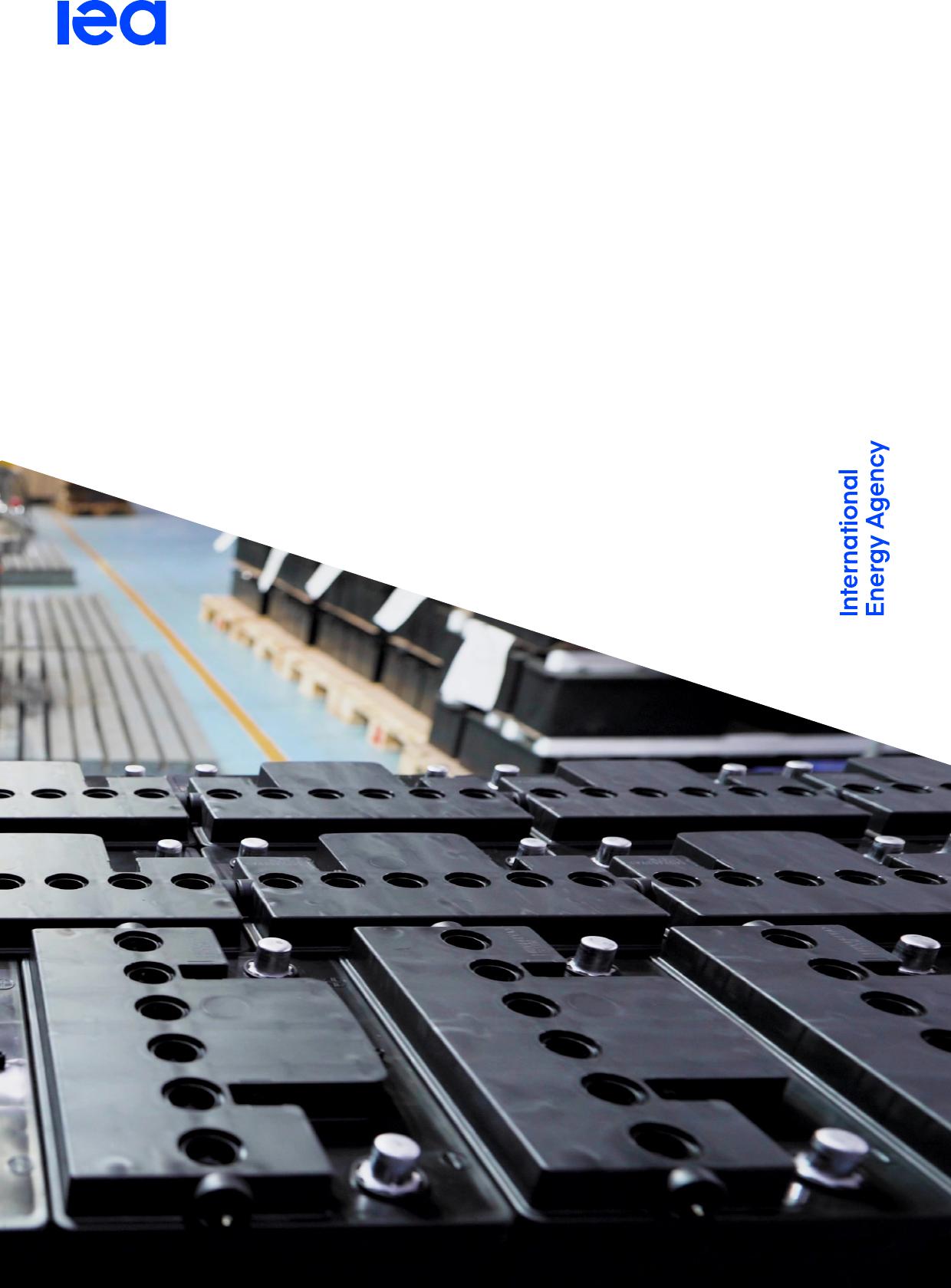TheStateofCleanTechnologyManufacturingAnEnergyTechnologyPerspectivesSpecialBriefingTheIEAexaminesthefullspectrumofenergyissuesincludingoil,gasandcoalsupplyanddemand,renewableenergytechnologies,electricitymarkets,energyefficiency,accesstoenergy,demandsidemanagementandmuchmore.Throughitswork,theIEAadvocatespoliciesthatwillenhancethereliability,affordabilityandsustainabilityofenergyinits31membercountries,11associationcountriesandbeyond.Thispublicationandanymapincludedhereinarewithoutprejudicetothestatusoforsovereigntyoveranyterritory,tothedelimitationofinternationalfrontiersandboundariesandtothenameofanyterritory,cityorarea.Source:IEA.InternationalEnergyAgencyWebsite:www.iea.orgIEAmembercountries:AustraliaAustriaBelgiumCanadaCzechRepublicDenmarkEstoniaFinlandFranceGermanyGreeceHungaryIrelandItalyJapanKoreaLithuaniaLuxembourgMexicoNetherlandsNewZealandNorwayPolandPortugalSlovakRepublicSpainSwedenSwitzerlandRepublicofTürkiyeUnitedKingdomUnitedStatesTheEuropeanCommissionalsoparticipatesintheworkoftheIEAIEAassociationcountries:ArgentinaBrazilChinaEgyptIndiaIndonesiaMoroccoSingaporeSouthAfricaThailandUkraineINTERNATIONALENERGYAGENCYTheStateofCleanTechnologyManufacturing:AnETPSpecialBriefingTableofcontentsPAGE3IEA.CCBY4.0.TableofcontentsKeyfindings...................................................................................................................4PartI:Introduction........................................................................................................6PartII:Analysis.............................................................................................................8Anupdateontechnologiesthatareadvancingrapidly..............................................................................8Recentdevelopmentsincleantechnologymanufacturing........................................................................9Regionalconcentrationincleantechnologymanufacturing....................................................................14Theglobalmarketforkeycleanenergytechnologies.............................................................................19PartIII:Recentpolicydevelopments.........................................................................23UnitedStates...........................................................................................................................................25EuropeanUnion......................................................................................................................................27China.......................................................................................................................................................30Othereconomies.....................................................................................................................................31PartIV:RecommendationsfortheG7.......................................................................33TheStateofCleanTechnologyManufacturing:AnETPSpecialBriefingKeyfindingsPAGE4IEA.CCBY4.0.Keyfindings•Cleanenergytechnologymanufacturingisexpandingrapidly,drivenbysupportivepolicies,ambitiouscorporatestrategiesandconsumerdemand.Theglobalenergycrisishasinstilledfurtherimpetustodevelopmanufacturingcapacitythatcanstrengthenenergysecurityanddiversifythesupplychain.ThisEnergyTechnologyPerspectives(ETP)SpecialBriefingisdesignedtoprovidepolicymakerswithstrategicinsightsinthisarea,focusingonfivecriticaltechnologies:solarphotovoltaic(PV),wind,batteries,electrolysersandheatpumps.•Newmanufacturingprojectsarebeingannouncedbytheday.IntheshorttimesincethelastIEAanalysisofcleantechnologymanufacturinginEnergyTechnologyPerspectives2023(coveringannouncementsthroughtolate2022),theprojectedoutputin2030fromannouncedprojectsforsolarPVhasincreasedby60%,forbatteriesithasincreasedbyaroundone-quarter,andforelectrolysersbyaround20%.•Itisnotjustannouncementsthatarepostingstronggrowthrates.Thelatestdataavailableforyear-end2022showinstalledmanufacturingcapacitypostedstrongyear-on-yeargrowthforbatteries(72%),solarPV(39%),electrolysers(26%)andheatpumps(13%).Windmanufacturingcapacitygrewmuchmoremodestlyataround2%.•Ifallannouncedprojectsweretocometofruition,solarPVmanufacturingcapacitywouldcomfortablyexceedthedeploymentneedsoftheIEA’sNetZeroEmissionsby2050(NZE)Scenarioin2030.Evenifonlyhalfofthisnewcapacityweretobeutilised–theglobalaverageutilisationrateofsolarPVmanufacturingcapacityin2022wasslightlyover40%–throughputwouldstillbesufficienttoreachdemandlevelsintheNZEScenario(around650GWperyearin2030).•Forthefirsttime,announcedprojectsforbatterymanufacturingcapacitycouldcovervirtuallyallofthe2030globaldeploymentneedsoftheNZEScenario.Significantgapsremainforwind,whereprojectedthroughputfromexistingcapacityandannouncedprojectsequatestojustunder30%ofNZEScenariodeploymentlevels,electrolysers(justover60%)andheatpumps(justover40%).Butrelativelyshortleadtimes–forbothannouncementsandconstruction–forthefactoriesthatsupplythesetechnologiesimplyamorepositiveoutlookthanthesegapsinitiallysuggest.•WhilethepipelinesofannouncedprojectsforsolarPVandbatteriesappearwell-stocked,manyoftheprojectstheycomprisehavenotyetstartedconstructionorreachedafinalinvestmentdecision.Globally,onlyaround25%oftheannouncedprojectsforsolarPVmanufacturingcapacitycanbeconsideredcommitted,withtheequivalentfigureforbatteriesbeingaround30%.•Manufacturingoperationsarehighlygeographicallyconcentrated:currently,fourcountriesandtheEuropeanUnionaccountforaround80-90%ofglobalmanufacturingcapacityforthefivecleantechnologiesexaminedinthisbriefing.Chinaaloneaccountsfor40-80%acrossthesetechnologies.Ifallannouncedprojectsweretoberealised,theseshareswouldshiftto70-95%and30-80%respectively.•Majorpolicyannouncementsofthepastyeararealreadystartingtodiversifysupplychains,asevidencedbythescale-upinplannedbatterymanufacturingcapacityintheUnitedStatesfollowingadoptionoftheInflationReductionAct.IntheUnitedStates,justtheannouncementsinthesecondhalfof2022andthefirstquarterof2023accountfornearlyTheStateofCleanTechnologyManufacturing:AnETPSpecialBriefingKeyfindingsPAGE5IEA.CCBY4.0.halfofthetotalprojectpipelineforbatterymanufacturingto2030.ThefullimpactsoftheNetZeroIndustryActintheEuropeanUnionarestilltooearlytogauge.•Inmonetaryterms,theprojectedoutputoftheannouncedmanufacturingcapacityforthefivekeycleantechnologies(USD790billionperyear)nowexceedsthatofthemarketsizefortheirdemand(USD640billion)in2030,inascenarioinwhichgovernmentsimplementtheirannouncedclimatepledgesontimeandinfull–theAnnouncedPledgesScenario(APS).Theaggregatesupplysurplusatthegloballevelismirroredforindividualtechnologies(solarPV,batteriesandelectrolysers),butmasksdeficitsforothers(windandheatpumps).Inaggregate,thissuggeststhatforseveraltechnologies,thedeploymentlevelsneededtomeetgovernments’climatepledgesintheAPSarehighlyachievable.•ChinaappearswellpositionedtocaptureUSD500billion,oraround65%oftheprojectedoutputfromglobalcleantechnologymanufacturingcapacityin2030,includingbothexistingandannouncedprojects.UnlessChina'sdomesticdeploymentofkeycleantechnologiesexceedsthelevelsprojectedintheAPS,morethantwo-thirdsofthisoutputwouldbesurplustodomesticrequirementsandneedtofindexportmarkets.•Ifallannouncedprojectsarerealised,theEuropeanUnionnowappearsabletofulfilallofitsdomesticneedsforbatteries,electrolysersandheatpumpsintheAPSin2030.TheUnitedStatescouldalsobevirtuallyself-sufficientwithrespecttoitsbatteryneedsby2030intheAPS,basedontheselatestprojectannouncements.•ThisbriefingconcludeswithasetofpolicyrecommendationstargetedatG7members,butapplicabletoallinterestedgovernments.Theyreflectthefactthatnocountry–noranysupplychainsegment–canexistinavacuum.Fromstrategicsupplychainassessmentstostrategicpartnerships,governmentswillneedtoformulateindustrialstrategiesthatbalanceclimateandenergysecurityimperativeswitheconomicopportunities.TheStateofCleanTechnologyManufacturing:AnETPSpecialBriefingPartI:IntroductionPAGE6IEA.CCBY4.0.PartI:IntroductionDeployingcleanenergytechnologiesatthepacerequiredtoputtheworldonatrajectoryconsistentwithnetzeroemissionsbymid-centurywilldemandrapidexpansionincleanenergytechnologymanufacturing1capacity,underpinnedbyrobustsupplychainsfortheircomponentsandmaterials.Assuch,technologymanufacturingplaysapivotalroleintheenergytransitionrequiredtomeetclimate,energysecurityandeconomicdevelopmentgoals.ChangeisalreadyhappeningapaceinsectorssuchaselectricvehiclesandsolarPV,heraldinganewerainmanufacturing,withcountriesaroundtheworldintroducingpoliciestoshoreuptheirpositionintheemergingcleanenergyeconomy.Thisfast-movingtransitionhasbeengivenaddedimpetusbythecurrentglobalenergycrisis,whichhasincreasedenergysecurityconcernsandstarklyillustratestheneedforcleanenergytechnologieswithdiversifiedsupplychains.Theplaceofcleantechnologymanufacturinginindustrialstrategyistodayacriticalconsiderationforgovernments,withpolicymakerscommittingtoscaleupinvestmentsanddiversifysupplychains.Strategicpolicymakingintheareaofcleantechnologymanufacturingwillrequireaclearunderstandingoftheexpecteddemandforcleanenergytechnologiesindifferentregionalandpolicycontexts,andanassessmentofbottlenecksthatneedtobeaddressedinordertofulfilclimateambitions.Thisbriefingprovidesanupdateonrecentprogressincleantechnologymanufacturinginkeyregions.ItbuildsuponthelatesteditionoftheIEA’sflagshiptechnologypublication,EnergyTechnologyPerspectives2023(ETP-2023),publishedinJanuary2023.TheanalysisinETP-2023hasbeenupdatedtotakeintoaccountrecentannouncementsofexpansionsinmanufacturingcapacity,inordertoinformconsiderationsbydecisionmakersseekingtotapintotheopportunitiesofferedbytheemergingcleanenergyeconomy.Webeginwithareviewofrecentdevelopments,exploringhowfarthecurrentprojectpipelineisconsistentwiththetrajectoryneededtoreachnetzeroemissionsby2050.Weconsiderwherethesedevelopmentsareoccurringbytechnologytoassesslevelsofregionalconcentrationincleantechnologymanufacturing.Wegoontoconsidertheglobalmarketforkeycleanenergytechnologies,andfinallytoexplorehowrecentpolicydevelopmentsareshapingthelandscapeofcleantechnologymanufacturing.1Hereafter“cleantechnologymanufacturing”.TheStateofCleanTechnologyManufacturing:AnETPSpecialBriefingPartI:IntroductionPAGE7IEA.CCBY4.0.Box1ScenariosusedinthisbriefingAnalysisinthisbriefingisunderpinnedbyglobalprojectionsofcleanenergytechnologiesderivedfromtheIEA’sGlobalEnergyandClimate(GEC)model,adetailedbottom-upmodellingframeworkcomposedofseveralinterlinkedmodelscoveringenergysupplyandtransformation,andenergyuseinthebuildings,industryandtransportsectors.Themodellingframeworkincludes26regionsorcountriescoveringthewholeworld.ThemostrecentyearofcompletehistoricaldatafromtheGECmodelis2021,towhichyear-end2022manufacturingcapacitydatahavebeenaddedaspartoftheanalysisforthisbriefing.DataforQ12023areavailableforsometechnologies.Forprojectedvalues–wefocuson2030inforward-lookingassessments–wemakeuseoftwoIEAscenariosproducedusingtheGECmodelthatdescribepossibleenergysystempathways:TheNetZeroEmissionsby2050(NZE)Scenarioisanormativescenariothatsetsoutapathwaytostabiliseglobalaveragetemperaturesat1.5°Cabovepre-industriallevels.TheNZEScenarioachievesglobalnetzeroenergysectorCO2emissionsby2050withoutrelyingonemissionsreductionsfromoutsidetheenergysector.Indoingso,advancedeconomiesreachnetzeroemissionsbeforedevelopingeconomiesdo.TheNZEScenarioalsomeetsthekeyenergy-relatedUNSustainableDevelopmentGoals,achievinguniversalaccesstoenergyby2030andsecuringmajorimprovementsinairquality.TheAnnouncedPledgesScenario(APS)assumesthatgovernmentswillmeet,infullandontime,alltheclimate-relatedcommitmentstheyhaveannounced,includinglonger-termnetzeroemissionstargetsandNationallyDeterminedContributions(NDCs),aswellascommitmentsinrelatedareassuchasenergyaccess.Itdoessoirrespectiveofwhetherthesecommitmentsareunderpinnedbyspecificpoliciestosecuretheirimplementation.Pledgesmadeininternationalforaandinitiativesonthepartofbusinessesandothernon-governmentalorganisationsarealsotakenintoaccountwherevertheyaddtotheambitionofgovernments.Neitherscenarioshouldbeconsideredapredictionorforecast.Rather,theyareintendedtoofferinsightsintotheimpactsandtrade-offsofdifferenttechnologychoicesandpolicytargets,andtoprovideaquantitativeframeworktosupportdecision-makingintheenergysector,andstrategicguidanceontechnologychoicesforgovernmentsandotherstakeholders.ThescenariosandresultsareconsistentwiththosepresentedintheWorldEnergyOutlook2022,andETP-2023,withtheexceptionofbatterydemand,whichhasbeenrevisedbasedonupdatespresentedintheGlobalEVOutlook2023.TheStateofCleanTechnologyManufacturing:AnETPSpecialBriefingPartII:AnalysisPAGE8IEA.CCBY4.0.PartII:AnalysisAnupdateontechnologiesthatareadvancingrapidlyTheIEAreportEnergyTechnologyPerspectives2023(ETP-2023)analysedtherisksandopportunitiessurroundingthedevelopmentofcleanenergytechnologysupplychains,exploringallthemajorstepsthroughoutthesupplychain.Thisbriefingexaminesthemanufacturingstepsinmoredetail,withaspecificfocusonfivekeytechnologiesforthecleanenergytransition:solarPVmodules,2windturbines,3batteries,4electrolysers5andheatpumps.6Manufacturingcapacityexpansionsforthesetechnologiestendtohaveshorterleadtimesthanotherstepsinthesupplychain,suchasmining.Thismeansthatprogressfromannouncementtooperationcanbeespeciallydynamicinasupportiveenvironment.Thesesupplychainstepshavealsobeenstronglyemphasisedinrecentpolicyannouncements.Themanufacturingdatacompiledforthisbriefing(seeBox2)aimstocapturetheselatestdevelopmentsandprovideasnapshotofthecurrentoutlookforcapacityadditionsthroughto2030.OfparticularinterestiswhetherrecentprojectannouncementshavechangedthepicturewithrespecttothesignificantdegreeofregionalconcentrationincleantechnologymanufacturingrevealedinETP-2023,andwhichcountriesandregionsappearbest-positionedtocapturesharesofthemarketsforkeycleantechnologiesinthecomingyears.Box2ManufacturingdatacompiledforthisbriefingThemanufacturingdatacompiledforthisbriefing,coveringthefivefocuscleanenergytechnologies–solarPV,wind,batteries,electrolysersandheatpumps–canbecategorisedasfollows:“Installedmanufacturingcapacity”referstothemaximumratedoutputoffacilitiesforproducingagiventechnology,asdistinguishedfromtheinstalledcapacityofthetechnologiesthemselvesoncedeployed.Capacityisstatedonanannualbasisforthefinalproduct(e.g.solarPVmodules)anddoesnotspeakto2Hereafter“solarPV”,unlessaparticularcomponentorintermediatestepinproductionisspecified.3Hereafter“wind”,withanalysisbasedonaggregateoraveragequantitiesfornacelles,towersandbladesasappropriate.4Includingbothmobileandstationaryapplicationsandallbatterychemistries.5Includingbothalkalineandprotonexchangemembranetechnologies.6Forresidentialapplicationsonly.TheStateofCleanTechnologyManufacturing:AnETPSpecialBriefingPartII:AnalysisPAGE9IEA.CCBY4.0.thecapacityforproducinganyintermediateproductsandcomponents(e.g.polysilicon).Manufacturingthroughput–alsostatedonanannualbasis–isafractionoftheinstalledmanufacturingcapacity.Itdependsontheutilisationrateofproductionfacilities,whicharetypicallyaround85%ifoperatingnormally,butaresometimesmuchlower.ETP-2023covereddataforinstalledmanufacturingcapacitytoyear-end2021;inthisupdatedataforyear-end2022areadded.“Announcedprojects”referstotheaggregatestatedcapacity–orestimatedthroughputofthatcapacityassumingadefaultutilisationrateof85%–ofpotentialfuturemanufacturingfacilitiesforwhichprojectshavebeenannounced.Announcementsincludeprojectsthatareatdifferentstagesofdevelopment,withsomealreadyunderconstructionandothersnotyetatthefinalinvestmentdecisionstage.Thequantitiesassociatedwiththeseprojectsarenotaforecast,noraretheydirectlyassociatedwiththeprojectedquantitiesembodiedbythescenariosdescribedinBox1.Actualmanufacturingcapacityadditionscouldturnouttobehigherthancurrentpublicannouncementsatagivenpointintime,orlower,asnotallannouncedprojectswillmaterialise.Assuch,theyprovideanindicatorofwheretheindustryisheaded,butnotanexpectationontheeventualoutcome.Howthesefactorsplayoutwillvarybytechnologyandbyregionalcontext.ETP-2023providedasnapshotofannouncedprojectsasofend-November2022(hereafter“late2022”);thisbriefingcoversthoseprojectannouncementsandinadditionanyfurtherannouncementsuptoend-March2023(hereafter“end-Q12023”).Unlessstatedotherwise,forward-lookingquantitiesassociatedwiththecapacityorthroughputofannouncedprojectsincludeallprojectsinoperationuptoandincludingtheyear2030.Completedataonmanufacturingcapacityandthroughputhavebeencompiledfor2021and2022.Projectannouncementsarecompiledonanon-goingbasisforelectrolysers,onamonthlybasisforsolarPVandbatteries,andonanad-hocbasisforwindandheatpumps.NonewquantifiabledataonprojectannouncementswereavailableforwindsincethepublicationofETP-2023,andthusthereisnochangeinthequantificationofannouncedprojectsforthattechnologyinthisbriefing.ExternaldataprovidersincludeInfoLink,ThomsonReuters,BloombergNewEnergyFinance,WoodMackenzie,andBenchmarkMineralIntelligence.RecentdevelopmentsincleantechnologymanufacturingAreviewofthelatestprojectannouncementsforcleantechnologymanufacturingshowsthatsomemanufacturingsectorslooksettomeet–andeventoexceed–thecapacityrequiredby2030togetontrackwiththedeploymentneedsoftheTheStateofCleanTechnologyManufacturing:AnETPSpecialBriefingPartII:AnalysisPAGE10IEA.CCBY4.0.NZEScenario.Othersarelaggingbehind,withsubstantialincreasesinambitionrequiredtomeetemissionsreductiongoals,butprogresshasbeenmadeinthepastfewmonths.Giventheshortleadtimesrequiredtobringmanufacturingcapacityonline,reachingthe2030deploymentlevelsintheNZEScenario,thoughasignificantchallenge,isnotaninsurmountableoneforthesetechnologies.Figure1Announcedprojectthroughputanddeploymentforkeycleanenergytechnologiesin2030intheNetZeroEmissionsby2050ScenarioIEA.CCBY4.0.Notes:PV=photovoltaic;NZEScenario=NetZeroEmissionsby2050Scenario.“Announcedprojects:late2022”correspondstotheprojectpipelineassessedforETP-2023,includingprojectannouncementsthroughtotheendofNovember2022.“Announcedprojects:Additionaltoend-Q12023”correspondstoprojectsannouncedbetweentheendofNovember2022andtheendofMarch2023.Deploymentandthroughputareexpressedinphysicalunits,normalisedto2030NZEScenariodeploymentneeds.ForsolarPVandbatteries,announcedprojectstodayalreadymeetandevenexceedthedeploymentlevelsrequiredintheNZEScenarioin2030.Shortleadtimessuggestthegapsremainingforwind,heatpumpsandelectrolysers,thoughsignificant,arenotinsurmountable.SolarPVmanufacturingcontinuestoexpanddramaticallySolarPVmanufacturing–whichincreasedatacompoundannualgrowthrateof25%duringtheperiod2010-2021–showsnosignofslowingdown.In2021,manufacturingthroughputstoodjustover190GWglobally,comparedwitharound160GWofsolarPVdeployedinthesameyear.In2022,globalmanufacturingcapacityrosebynearly40%toabout640GW,with90%ofthegrowthrelativeto2021takingplaceinPeople’sRepublicofChina(hereafter,“China”).Manufacturingthroughputin2022wasaround260GW,significantlybelowthe640GWofinstalledmanufacturingcapacity–indicatingaglobalaverageutilisationrateofaround40%.Asoflate2022,ouranalysisofannouncedprojectsforsolarPVsuggestedthatmanufacturerswerealreadyontracktomeetprojecteddemandin2030intheNZEScenario,withabout670GWofthroughputbythatyearresultingfrom0%50%100%150%200%SolarPVBatteriesWindHeatpumpsElectrolysersShareof2030NZEScenariodeployment20212022Asoflate2022Additionaltoend-Q12023GaptoNZENZEScenariodeploymentneedsin2030Installedmanufacturingcapacity:Announcedprojects:TheStateofCleanTechnologyManufacturing:AnETPSpecialBriefingPartII:AnalysisPAGE11IEA.CCBY4.0.announcementsforadditionalmanufacturingcapacity.Asofend-Q12023,theprojectpipelinehasexpandedevenfurther.Around480GWofadditionalmodulemanufacturingcapacityhasbeenannounced(570GWofcells,250GWofwafers,570GWofpolysilicon),increasingthetotalvolumeofplannedcapacityby60%.Theresultisnearly1.1TWofprojectedthroughputfromthisannouncedmanufacturingcapacityformodules,which,whencombinedwithcurrentinstalledcapacity,is65%higherthanthelevelrequiredtosatisfydeploymentneedsundertheNZEScenarioin2030.WhenexaminingtheprojectedoutputforothermajorPVcomponents–albeitwithashortertimehorizonforannouncedprojectsuptoandincluding2027–thefiguresare80%,37%and96%forcells,wafersandpolysiliconrespectively.However,onlyaround25%oftheannouncedmodulemanufacturingcapacityiscommitted,i.e.underconstructionorhavingreachedfinalinvestmentdecision.Evenconsideringjusttheseprojects–alongsideexistingcapacityof640GW–theprojectpipelineappearscapableofaccommodatingtheNZEScenariodeploymentneedsby2030,ifutilisationratesincreaseto85%onaveragegloballybythen.Majorproject7announcementsmadeinQ12023includenewmanufacturingfacilitiesfortheworld’stopthreeproducers–LONGi,JinkoSolarandTrina–aswellasforotherlarger(e.g.Tongwei,Suntech)andsmalleroremergingplayers(e.g.SolarGrids,RECGroup,Hoshine,Royal),mostlybasedinChina.Thesemajorprojectsaccountfor45%ofthetotaladditionalcapacityannouncedasofQ12023.AccelerationinbatterymanufacturingisclosingthegapwithnetzeroneedsBatterymanufacturingcapacityisalsobooming,owingtorapidincreasesinelectricvehicle(EV)sales.In2021,batterymanufacturingthroughputstoodat340GWh,withthisfigurenearlydoublingtoreach660GWhin2022.580GWhofmanufacturingcapacitywasaddedin2022,up85%fromthecapacityaddedin2021.About80%ofthe2022manufacturingcapacityadditionswereinChina,justover10%inEuropeandjustunder10%intheUnitedStates.Around90%ofthesebatteriesarecurrentlydestinedforautomotiveapplications.Globalelectriccarsalesroseby55%year-on-yearin2022,withtheshareofelectriccarsintotalcarsalesreaching14%,upfrom9%in2021.InmajormarketssuchasChinaandEuropethissharereached29%and21%,respectively.Salesalsorosetoanearly8%shareintheUnitedStates,representing55%year-on-yeargrowth.Lookingatthepipelineofannouncedprojects,fromlate2022toend-Q12023,plannedmanufacturingcapacityhasrisenfromaround5.5TWhto6.8TWhper7“Majorprojects”referstoplantswithstatedproductioncapacitygreaterthanorequalto20GWperyearforsolarPVmodules.Tocompare,theaveragemanufacturingcapacityofasolarPVmoduleplantwasaround2.8GWperyearin2022.TheStateofCleanTechnologyManufacturing:AnETPSpecialBriefingPartII:AnalysisPAGE12IEA.CCBY4.0.year–anincreaseof25%.Asoflate2022,thetotalpotentialoutputfromtheseannouncedprojectsstoodataround80%ofwhatwasneededby2030tobeontrackwiththeNZEScenario.Theupdatedassessmentperformedforthisbriefingnowputsthetotalprojectedoutputfromtheseprojectsjustbelowthelevelsrequired(5.9TWhannually),demonstratingstronginvestmentin–andstrongpolicysupportanddemandfor–batterymanufacturing.Weestimatethataround30%oftheseprojectscanbeconsideredcommittedglobally,withtheproportionbeingslightlyhigherintheUnitedStates(justunder40%)butmuchlowerintheEuropeanUnion(around10%).Ifonlycommittedprojectsmaterialised,therewouldbeagaptoglobalNZEScenariodeploymentlevelsofaround50%in2030.MajorprojectannouncementsforsolarPVandbatterymanufacturingoperationsinQ12023CompanyLocationCountryProductioncapacityProjectedcompletionyear/yearreachingmaximumthroughputBatteriesTeslaAustinUS200GWh2024/2025-2030CATLYibinChina186GWhOperating/>2030CATLFudingChina120GWhOperating/2025-2030LGESWroclawPoland115GWhOperating/2025CATLDebrecenHungary100GWh2025/2028LGESNanjing1China92GWhOperating/>2030CALBChangzhouChina90GWhOperating/2025-2030TeslaBerlinGermany85GWh2024/>2030CATLLuoyangChina80GWh2025/2025-2030SolarPVJinkoSolarYuhuanChina30GW2024/2025SolargridsZhuhaiChina30GW2024/2024TongweiYanchengChina25GW2023/2023TongweiNantongChina25GW2023/2024JinkoSolarShangraoChina24GW2023/2025LONGiTaizhouChina20GWOperating/AlreadyatmaximumLONGiWuhuChina20GW2023/2025TrinaYanchengDafengChina20GWOperating/2024SuntechChuzhouFengyangChina20GW2023/2024RECGroupJamnagarIndia20GW2023/2026SolargridsYiwuChina20GW2024/2024HoshineUrumqiChina20GW2023/2026RoyalFuyangChina20GW2023/2025Notes:PV=photovoltaic.“Majorprojects”refertoplantswithstatedproductioncapacityby2030greaterthanorequalto20GWperyearforsolarPVmodulesand80GWhperyearforelectricvehiclebatteries.Anyanticipatedexpansionsbeyond2030havenotbeenincluded.Thebatterymanufacturingfacilitiesincludeallkindsofchemistries,bothformobilityaswellasstationaryapplications.TheStateofCleanTechnologyManufacturing:AnETPSpecialBriefingPartII:AnalysisPAGE13IEA.CCBY4.0.AnnouncedprojectsforelectrolysersincreaseafteraslowstartElectrolysermanufacturingforuseintheproductionofhydrogenisstillanascentindustryandistheleastmaturetechnologyexaminedinthisbriefing.In2021,electrolysermanufacturingthroughputstoodataround7GW,increasingto9GWin2022.Lookingforward,announcedprojectsasofend-Q12023suggestnearly115GWofadditionalinstalledmanufacturingcapacitycouldbeexpectedby2030.Theresultingthroughputprojectedfromtheseannouncedprojects–togetherwiththatfromexistinginstallations–wouldachievemorethan60%ofthelevelsneededintheNZEScenarioin2030.Countingonlytheprojectsthatarecommitted,thatfiguredropstounder10%.Theprojectpipelineisexpectedtocontinuetogrowinthecomingyears,butannouncedprojectsneedearlysupporttoensurethattheyreachfinalinvestmentdecisions.Ifallplannedprojectswererealised,costsforelectrolyserscouldfallbymorethan60%by2030.WindandheatpumpmanufacturingisseeingmoregradualchangeDataformanufacturingcapacityofwindandheatpumpsismorelimited,andsoitistooearlytotellwhethertherehavebeensignificantchangesinthefirstmonthsofthisyear.Weestimatethatmanufacturingthroughputforwindwasaround100GWin2022,andjustunder120GWforheatpumps.Alargegapbetweenexpectedoutputfromannouncedprojectsand2030NZEScenarioneedsexistsforbothtechnologies:agapofover70%forwindandnearly60%forheatpumps.However,leadtimesforconstructingthesefacilitiescanberelativelyshortinmanycases,around1-3years.VirtuallyalloftheprojectannouncementsforheatpumpsaresituatedinEurope,althoughthismaybebecausecapacityadditionsinotherregionsareoftennotasprominentlyorexplicitlyannouncedasforothertechnologies,partlybecauseheatpumpsoftenrepresentasmallproportionofamanufacturer’stotalproduction.Heatpumpmanufacturingcapacityexpansionstypicallyfollownear-termdemandtrendswithoutexplicitannouncements.Assuch,thegapstotheNZEScenariodeploymentlevelsmayappearlargerthantheyreallyare.IfweassumethatasimilarshareofalreadyinstalledcapacitytothatinEuropeisforthcominginotherregions,theexistinggaptothe2030NZEScenariodeploymentlevels,whichiscurrentlyataround60%globally,wouldfalltoaround20%.Acompletesetofquantitativedataonthemostrecentannouncementsforwindcomponents–nacelles,towersandblades–isnotavailableatthetimeofpreparingthisbriefing.However,preliminaryanalysisofcomponent-levelprojectannouncementssuggeststhatforonshorewindcomponents,manufacturingcapacitycouldreach100-110GWby2025,ofwhich60%wouldbelocatedinChina,15%inEuropeandabout10%inNorthAmerica.Foroffshoreinstallations,TheStateofCleanTechnologyManufacturing:AnETPSpecialBriefingPartII:AnalysisPAGE14IEA.CCBY4.0.projectannouncementssuggestamanufacturingcapacityofaround30GW,ofwhicharound70-80%isinChinaandmuchoftherestinEurope.RegionalconcentrationincleantechnologymanufacturingForthecleanenergytechnologiesconsideredinthisbriefing–solarPV,wind,batteries,electrolysersandheatpumps–fourcountriesandtheEuropeanUnionaccountfor80-90%ofmanufacturingcapacity,withChinaintheleadforall.Forcleantechnologysupplychainsmorebroadly,thereareimportantlevelsofconcentrationateachofthemajorsteps,andnotjustinmanufacturing.Forexample,theDemocraticRepublicofCongoaloneproduces70%oftheworld’scobalt,andjustthreecountriesaccountformorethan90%ofgloballithiumproduction.Concentrationatanypointalongasupplychainmakestheentiresystemvulnerabletounforeseenchanges,suchasanindividualcountry’spolicychoices,naturalhazards,technicalfailuresorcompanydecisions.Figure2CurrentandprojectedgeographicconcentrationformanufacturingoperationsforkeycleantechnologiesIEA.CCBY4.0.Notes:PV=photovoltaic.Windreferstoonshorewindnacellesinthisanalysis.Forelectrolysers,theanalysisonlyincludesprojectsforwhichlocationdatawasavailable.Sharesarebasedonmanufacturingcapacity.‘Current’referstoinstalledcapacitydatafor2022andQ12023whereavailable.“Projectpipeline”referstothesumofcurrentinstalledcapacityandallannouncedmanufacturingcapacityadditions(asofend-Q12023)throughto2030.“Other”referstotheaggregateofallcapacitybesidesthatofthetopthreecountries/regionsforeachtechnologyandtimeframe.Announcedprojects–ifallrealised–willaltertheglobaldistributionofmanufacturingcapacityforbatteries,electrolysersandheatpumps.0%20%40%60%80%100%CurrentProjectpipelineCurrentProjectpipelineCurrentProjectpipelineCurrentProjectpipelineCurrentProjectpipelineSolarPVWindBatteriesElectrolysersHeatpumpsChinaVietNamIndiaEuropeanUnionUnitedStatesOtherTheStateofCleanTechnologyManufacturing:AnETPSpecialBriefingPartII:AnalysisPAGE15IEA.CCBY4.0.China’sprominentroleintechnologymanufacturingistheresultofalong-termindustrialstrategy,resultinginhugeinvestmentincleanenergysupplychains,driveninpartbyconsistentpolicysignalsfordomesticcleantechnologydeploymentinitssuccessiveFive-YearPlans.ThisinvestmenthashelpedtoreducethecostsofcleanenergytechnologiesinChina,andintherestoftheworld,whileatthesametimemakingChinatheleadingexporterofseveralcleanenergytechnologies.Inthefollowingsection,weexaminehowtheoutlookforgeographicalconcentrationofmanufacturingoperationsmaychangebasedontheupdatedpipelineofannouncedprojectsdevelopedforthisbriefing.SolarPVIn2022,threecountriesaccountedfornearly90%ofinstalledcapacityformanufacturingsolarPVmodules,withChinaaloneaccountingfor80%.SomeindividualplantsinChinaarecountry-sizedwithrespecttotheirratedproductioncapacity.ThelargestoperatingplantinChina–theLONGiplantinTaizhou(seeTable1)–islargeenoughtosupplynearly75%ofthecapacityadditionsofsolarPVmodulesintheEuropeanUnionin2022,whichtotalled38GW.ThenexttwolargestcountrieswithrespecttoinstalledmanufacturingcapacityareVietNamandIndia,accountingfor5%and3%ofallcapacity,respectively.ThelargestplantsinthesecountriestendtobemuchsmallerthanthoseinChina,ataround7-8GWofannualproductioncapacity.Ifallannouncedprojectscometofruition,concentrationamongthetopthreeproducerswouldremainverysimilartothecurrentlevel(90%).Theshareoftoday’ssecondlargestcountrybyinstalledcapacity,VietNam,wouldgivewaytoIndia,today’sthirdlargest,aswellastotheUnitedStates,whichwouldmovetothird,justaheadofVietNam.China’ssharewouldremainvirtuallyunchangedataround80%.Thesehighlevelsofconcentrationreflect,inpart,thefactthatsolarPVisalreadyamaturetechnology,withlarge-scaledeploymenttakingplaceinnearlyallregionsoftheworld.SolarPVaccountedfornearly40%ofglobalelectricitygenerationcapacityadditionsin2022,andnowaccountsfor4%ofglobalelectricitygeneration.Theconcentrationofcapacitylevelsinmatureindustriesisinherentlymorestablethaninnascentindustries,asannualcapacityadditionsaccountforsmallersharesofthecumulativecapacityinstalled.TheStateofCleanTechnologyManufacturing:AnETPSpecialBriefingPartII:AnalysisPAGE16IEA.CCBY4.0.Box3ConcentrationinsolarPVcomponentmanufacturingManufacturinganycleantechnologyisdependentonmanydifferentsupplychainsforcomponents,andconcentrationatanylevelcancreatevulnerabilitieswiththepotentialtoaffecttheentiresupplychainforagiventechnology,justasitcanforthewidersystemofcleantechnologysupplychains.AcloserlookatthecomponentsthatmakeupsolarPVpanelshighlightsevenhigherdegreesofconcentrationthanthoseofthefinishedmodulesalone.SolarPVmodulesareassembledfromcells,whichinturnaremadefromwafers,whichinturnaremadefrompolysilicon.AsolarPVmanufacturingfacilityrarelycomprisesallofthesesteps,buteachisnecessarytothemanufactureofthefinalmodule.Chinaisthesinglelargestproducerforallthreesub-components(cells,wafers,polysilicon)today,accountingfor85-97%ofglobalinstalledcapacityateachstageinthesupplychain.Thissupplychainconcentrationhasincreasedovertime,forsomecomponentsmorethanothers.Chinahaslongbeenaleaderinsiliconwaferproduction,accountingforaround80%ofproductionin2010,withthissharerisingtomorethan95%inrecentyears.Forcellsandmodules,alowerbutstillconsiderableshareof55-60%ofmanufacturingcapacityin2010hasrisenovertimetoover85%forcellsand80%formodulesin2022.Forpolysilicon,Chinaaccountedforlessthan30%oftheworld’smanufacturingcapacityin2010,withthissharerisingrapidlytoover85%in2022.ChinaisamajorexporterofsolarPVpanels,asdomesticmanufacturingcapacityforsolarPVmoduleshasexceededdomesticdemandsincethe2000s.ThishasbeenachievedthroughclearandsustainedpolicysignalsanddeploymenttargetsinitsFive-YearPlans.Since2010,installedcapacityofsolarPVhasgrownatacompoundannualgrowthrateofover65%,reaching427GWin2022.Thiscomparestoacompoundannualgrowthrate(CAGR)overthesameperiodof40%andinstalledcapacityin2022of140GWintheUnitedStates,andjustunder20%and200GWinEurope.ExaminingannouncedprojectsateachstageinthesolarPVsupplychain,weseethatChina’ssharesateachofthesestageswouldremainflatformodulesandcells,fallmodestlyforwafersandincreasemodestlyforpolysiliconthroughto2027,ifallprojectsweretocometofruition.TheseslightchangesinChina’sshareswhenprojectingforwardareprimarilyduetoprojectannouncementsinIndia,Thailand,theUnitedStatesandVietNam.WhilecapacityadditionsinthesecountrieswouldbesmallrelativetoChina’slargeexistingstock,theywouldrepresentsignificantincreasesindomesticmanufacturingcapacity.Formodules,announcedprojectswouldleadtoasixfoldincreaseinmanufacturingcapacityintheUnitedStates,andatriplinginIndia.Forcells,therewouldbeatenfoldincreaseinIndiaandadoublinginVietNamandThailand.Forwafers,IndiawouldTheStateofCleanTechnologyManufacturing:AnETPSpecialBriefingPartII:AnalysisPAGE17IEA.CCBY4.0.becomesecondlargestglobalmanufacturerandtheUnitedStateswouldrankthirdglobally,startingfromvirtuallyzeroproductionin2022.Figure3Currentandprojectedgeographicconcentrationofmanufacturingoperationsforkeysolarphotovoltaic(PV)componentsIEA.CCBY4.0.Notes:Allvaluesstipulatedasashareofglobalproductioncapacity.Valuesfor2027correspondtoexistingcapacityandannouncedprojects(asofend-Q12023)combined.ManufacturingofkeysolarPVcomponentshasbecomeincreasinglyconcentratedinChinainrecentyearsandlookstoremainsointheshortterm.BatteriesIn2022,China,theEuropeanUnionandtheUnitedStatesaccountedforover90%ofglobalinstalledmanufacturingcapacity.Chinaaloneaccountedfor75%.TheEuropeanUnionaccountedfor8%andtheUnitedStates7%.Beyondthetopthree,Koreaalsohasasizeableshareofinstalledmanufacturingcapacity,at5%oftheglobaltotal.Ifallannouncedmanufacturingprojectsforbatteriescametofruition,thislevelofsupplyconcentrationwouldremainrelativelyflat,withChina,theUnitedStatesandtheEuropeanUnionstillaccountingforaround95%combined.China’ssharewoulddecreasemoderatelytoaroundtwo-thirdsofglobalmanufacturingcapacity,whilethatoftheUnitedStateswouldjumpto15%,andtheEuropeanUnion’sto11%.Thisisbecause–unlikesolarPV–thelargestso-called“gigafactory”projectannouncementsarenotsolelylocatedinChina.ThelargestprojectplannedispartofaTeslafacilityintheUnitedStates.At200GWhofannualproductioncapacity,thisprojectannouncementisequivalenttoaround13%ofglobalbatterymanufacturingcapacityinstalledtoday.20%40%60%80%100%20102016202120222027ShareofsinglelargestproducingcountryPolysiliconWafersCellsModulesInstalledAnnouncedprojectsTheStateofCleanTechnologyManufacturing:AnETPSpecialBriefingPartII:AnalysisPAGE18IEA.CCBY4.0.Electricvehiclemarkets–theprimarydriverofbatterymanufacturingcapacityadditions–arematuringrapidly,butsalesofEVsarestilloutweighedbysalesofinternalcombustionenginevehiclesglobally.WhilesolarPVhasbeenthelargestsinglesourceofcapacityadditionsinthepowersectorsince2017,electriccarsaccountedfor14%oftotalcarsalesin2022.However,salesareincreasingrapidly:electriccarsaccountedforjust2.6%ofcarsalesin2019,andareprojectedtoreach18%in2023.Therehavealsobeenimportantbatterytechnologydevelopmentsandbreakthroughsinrecentyearstocutcostsanddecreasecriticalmineralrequirements.AsEVpenetrationincreasesinmorecountriesandinnovativebatteryconceptsmature,thelandscapeforglobalbatterymanufacturingandregionalconcentrationcouldchange.Box4DiversificationforenhancedsecurityandresilienceincleanenergytechnologysupplychainsAddingmanufacturingcapacityisnottheonlywaytosecuresupplyfordomesticdemandinthelongterm.Wherepossible,pursuingdiversificationstrategiescanmoderatesupplychainrisksandincreaseresilience.Measurestoreduceoveralldemandandpromoterecyclingandreusecanalsohelp.Diversifyingtheoriginofsuppliesamongseveraltradepartners–foreitherfinishedgoods,technologycomponents,equipmentormaterials–canhelpincreaseresilienceinthecaseofsupplychainshocks.Diversifyingtechnologyandmaterialneeds,suchasthroughtechnologyormaterialsubstitution,canhelpreducestructuralrelianceonforeigntradeandincreasesecurityofsupply,includingincasesofhighregionalconcentrationforexistingtechnologiesandthematerialstheyrequire.InthecaseofEVbatteries,forexample,developinginnovativechemistrieswithlowercriticalmineralrequirements,suchasnickel-freelithiumironphosphate,ornone,suchastheemergingsodium-ionbatteries,cansignificantlydecreaseexposuretoregionalconcentrationofcriticalmineralsextractionandprocessing.Wind,electrolysersandheatpumpsManufacturingofonshorewindnacelleswasalsohighlyconcentratedin2022.Chinaaccountedforover60%ofglobalmanufacturingcapacity,followedbytheEuropeanUnion(justunder15%)andtheUnitedStates(10%).Ifallannouncedprojectsforadditionalcapacityweretocometofruition,theseshareswouldnotchangesignificantlyby2030.Regionalconcentrationalsovariesfordifferentpiecesofequipmentsuchastowersandblades,andoffshore-specificcomponents.Weestimatethatforonshoreequipmentoverall,announcedprojectsTheStateofCleanTechnologyManufacturing:AnETPSpecialBriefingPartII:AnalysisPAGE19IEA.CCBY4.0.wouldleadChinatoaccountfor55-65%ofglobalmanufacturingcapacityby2030,andupto70-80%foroffshoreequipment.Forelectrolysersandheatpumps,whiletheUnitedStates,ChinaandtheEuropeanUnioncombinedaccountedfornearly80%ofglobalmanufacturingcapacityin2022,capacityismoreevenlydistributedbetweenthem.Chinaaccountedforabout40%ofelectrolysermanufacturingcapacity,andtheEuropeanUnionandtheUnitedStates20%each.Forheatpumps,about35%ofmanufacturingcapacitywaslocatedinChina,25%intheUnitedStatesandalittleunder20%intheEuropeanUnion.Ifallannouncedprojectscametofruition,regionalconcentrationforelectrolysermanufacturingwoulddecreaseslightlyby2030andthedistributionamongthetopproducerswouldfurtherimprove:ChinaandtheEuropeanUnionwouldeachaccountforaquarterofglobalmanufacturingcapacity,andtheUnitedStates20%.Forheatpumps,thecombinedshareofglobalcapacityheldbythisgroup–theUnitedStates,theEuropeanUnionandChina–wouldremainat80%,ifnofurthercapacityannouncementsweremade.TheEuropeanUnionwouldholdthelargestshare(justaround35%),aheadofChina(justunder30%)andtheUnitedStates(justunder20%),butprojectannouncementsforthistechnologytendtobemorefrequentandprominentinEuropethaninotherregions.TheglobalmarketforkeycleanenergytechnologiesThecombinedglobalmarketforkeycleantechnologies–solarPV,batteries,wind,electrolysersandheatpumps–reachesUSD640billionperyearby2030intheAPS(seeBox1foradescriptionofthisscenario).DomesticdemandinChina,theEuropeanUnion,theUnitedStatesandIndiacombinedaccountsfornearlythree-quartersoftheglobalmarketforkeycleantechnologiesby2030inthisscenario.TheregionsofSoutheastAsiaandCentralandSouthAmericaaccountforafurther10%and3%respectively.Sinceourlastestimatesinlate2022–publishedinETP-2023–therehavebeennumerousadditionalprojectannouncements,therebyincreasingthetotalmarketvalueoftheircombinedprojectedoutputs.Asofend-Q12023,theprojectedoutputfromexistingandannouncedmanufacturingcapacityin2030wouldleadtoaglobalmarketsizeonthesupplysideofnearlyUSD790billion,whichisaTheStateofCleanTechnologyManufacturing:AnETPSpecialBriefingPartII:AnalysisPAGE20IEA.CCBY4.0.significantincreaserelativetoourpreviousestimateofaroundUSD625billion.8However,thisoverallfigurehidessignificantdisparitiesforindividualtechnologiesandregions.Figure4Marketsizesforkeycleanenergytechnologiesin2030IEA.CCBY4.0.Notes:APS=AnnouncedPledgesScenario.“Domesticsupplyfromannouncedprojects:Asoflate2022”correspondstotheprojectpipelineassessedforETP-2023,includingprojectannouncementsthroughtotheendofNovember2022.“Domesticsupplyfromannouncedprojects:Asofend-Q12023”correspondstoprojectsannouncedthroughtotheendofMarch2023.KeycleanenergytechnologiesincludesolarPV,wind,batteries,electrolysersandheatpumps.MarketsizeiscalculatedbasedontheunitcostforeachtechnologyintheAPS,excludinginstallationandconstructioncosts.Allmarketsizesandrevenuesareexpressedinundiscounted2021USdollars.IntheAPS,thecombinedglobalmarketforfivekeycleantechnologiesreachesUSD630billionperyearby2030.AnnouncedprojectsforsolarPVmodules–ifallrealised–coulddeliverUSD160billionperyearworthofoutputglobally,relativetoamarketsizeofaroundUSD55billionin2030intheAPS.ThiswouldresultinamorethanUSD100billionmanufacturingsurpluscomparedtodeploymentaccordingtocountries’netzeropledges.Manufacturerscannotoperatecontinuouslyatmaximumcapacity,andsosomeextracapacityisnecessary,butmoreclimateambitioncouldbebeneficialforthecommercialviabilityoftheseprojects.Similarly,ifallannouncedprojectsforbatteriesandelectrolysersweretoberealised,theywouldresultinsurplusesofaroundUSD170billionandjustunderUSD10billionrespectively.However,manufacturingprojectsannouncedforwindandheatpumpsfallshortoftheprojectedglobalmarketsizeintheAPSby8AfigureofUSD650billionwaspublishedinETP-2023,butthisincludedfuelcells,whicharenotincludedinthisanalysis.0200400600ChinaEuropeanUnionUnitedStatesIndiaSoutheastAsiaCentralandSouthAmericaRestofWorldUSDbillionAsoflate2022Asofend-Q12023APSDomesticsupplyfromannouncedprojects:Domesticdemand:TheStateofCleanTechnologyManufacturing:AnETPSpecialBriefingPartII:AnalysisPAGE21IEA.CCBY4.0.USD140billioncombined.Fortheselattertwotechnologies,thereisacleardemandgapthatcouldbefilledbynewmanufacturingprojects,andsizeableassociatedmarkets.SimilarimbalancesbetweenthemarketsizesassociatedwithAPSdeploymentlevels(demand)andprojectedoutputfromexistingandannouncedmanufacturingfacilities(supply)existwithincountriesandregions.Assumingthatdomesticproductionisfirstusedtomeetdomesticdemand,andfocusingonthefinalmanufacturedproductasopposedtoindividualsupplychaincomponents,theresultingimbalancecanprovidesomeindicationastothedirectionandmagnitudeoffuturetrade.Figure5MarketvalueofimbalancesbetweensupplyfromexistingandannouncedprojectsanddemandintheAnnouncedPledgesScenarioin2030forkeycleantechnologiesIEA.CCBY4.0.Notes:PV=photovoltaic.Marketimbalancesarecomputedastheprojectedoutputfromexistingandannouncedprojects(asofend-Q12023)lessAPSdeploymentneedsforeachcountry/regionin2030.Negativevaluesindicatethepotentialvalueofnetimportsandpositivevaluesindicatethepotentialvalueofnetexports.Figuresarecomputedbasedonthevalueofthefinalmanufacturedtechnology(e.g.solarPVmodules),withtradeinintermediatecomponents(e.g.cells)andmaterials(e.g.polysilicon)beingoutsidethescopeoftheanalysis.Alldomesticproductionisfirstusedtomeetdomesticdeploymentneeds,irrespectiveofexistingtradepatterns.Aroundtwo-thirdsoftheprojectedoutputfromexistingandannouncedcapacityinChinawouldbesurplustodomesticrequirementsintheAPSandwouldneedtofindexportmarkets.Globalclimateambitionwouldneedtoberaisedinorderforthemtodoso.-200-1000100200300400SolarPVWindBatteriesElectrolysersHeatpumpsUnitedStatesEuropeanUnionChinaIndiaWorld,bytechnologyKeycleantechnologies,bycountry/regionUSDbillionSolarPVWindBatteriesElectrolysersHeatpumpsDemand>productionProduction>demandTheStateofCleanTechnologyManufacturing:AnETPSpecialBriefingPartII:AnalysisPAGE22IEA.CCBY4.0.ChinaappearswellpositionedtocaptureUSD500billionin2030,oraround65%oftheoutputsofannouncedmanufacturingcapacityinmonetarytermsinthesameyear.UnlessChina’sdomesticdeploymentofkeycleantechnologiesexceedsthelevelsprojectedintheAPS,aroundtwo-thirdsofthisoutputonanetbasis(USD340billionperyear)wouldbesurplustodomesticrequirements,andwouldneedtofindexportmarkets.ForsolarPV,batteriesandelectrolysers,globalclimateambitionwouldneedtoberaisedinordertodoso,giventhatthesetechnologiesseeprojectedmanufacturingoutputinexcessofglobalAPSdeploymentrequirementsin2030.AnnouncedprojectsintheUnitedStatesputthecountryonatrajectorytocaptureUSD100billionofthesupply-sidemarketin2030,whilethecombineddomesticmarketisprojectedtogrowtonearlyUSD150billionintheAPS.ThisimpliespotentialnetimportneedsofnearlyUSD50billionifnoadditionalcapacityisforthcoming.Heatpumpsaccountfor40%ofthismarketimbalance,withwindturbinesandsolarPVaccountingformostoftherest.TheEuropeanUnion’sdomesticmarketimbalancebalancelookssettoreachUSD20billioninimportsforthesetechnologies,ifnomoremanufacturingcapacityisforthcoming.However,theNetZeroIndustryActandGreenDealIndustrialPlancanbeexpectedtochangeprojections.India’snettradebalanceisexpectedtoreachUSD25billioninimportsforthesetechnologies,withbatteriesaccountingforaroundUSD15billionofthis,intheabsenceofadditionalmanufacturingcapacity.TheStateofCleanTechnologyManufacturing:AnETPSpecialBriefingPartIII:RecentpolicydevelopmentsPAGE23IEA.CCBY4.0.PartIII:RecentpolicydevelopmentsTheageofcleantechnologymanufacturingoffersbigopportunitiesforthecountriesthatembraceit,includingpositivesynergieswithclimateandenergysecuritygoals,aswellasbenefitsforeconomicgrowth.Countrieswillneedtodefineindustrialstrategiesfitforthecleantechnologymanufacturingageinaccordancewiththeirnationalcircumstances,consideringpotentialstrengthswithregardstodifferenttechnologyareas,aswellaspriorityneedsforcollaborationandstrategicpartnershipswiththirdcountries.Governmentsseekingtostimulatedomesticmanufacturingalsohaveauniquepossibilitytoinfluencelocaldemandforcleanenergytechnologiesatthesametime,suchasbysupportingincentivesforpurchasingEVs.Forsuppliers,localmarketsofferbenefitssuchaslowertransportandadministrativecostsforreachingpotentialbuyers.Themajorityofannouncedmanufacturingprojectsacrossmostkeycleanenergytechnologiesdonothavecommittedinvestments.IntheUnitedStates,forexample,almost40%oftheannouncedbatteryfactoriesareunderconstructionwhereasthefigureisjust2%forelectrolysers.InEurope,theequivalentfiguresarearound10%and15%respectively.However,suchmanufacturingfacilitiescanbebroughtonlinewithrelativelyshortleadtimes–around1-3yearsonaverage–meaningthatdeploymentcanrapidlyscaleupifsupportismaintained.Likewise,manufacturingprojectsthathavebeenannouncedbutnotfirmlycommittedmayendupmovingtodifferentcountriesinresponsetopolicyshiftsandmarketdevelopments.Inaneraofgreatchange,projectdevelopersandinvestorsareonthelookoutforsupportivepoliciesthatcouldgivethemtheedgeindifferentmarkets,andsincethebeginningofthedecade,severalmajoreconomieshaveintroducednewpoliciestoboostdomesticcleantechnologymanufacturing.ExamplesfromthepastyearaloneincludetheInflationReductionActintheUnitedStates,theNetZeroIndustryActintheEuropeanUnionandvariousmilestonesinJapan’sGreenTransformationprogramme.TogetherwithChina’slatestFive-Year-Plan(2021-2025)andIndia’sProductionLinkedIncentivescheme,thesepoliciesaretransformingindustrialpolicyrelevanttocleanenergytechnologyandreshapingthebalanceofglobaltrade.Inthispartofthebriefing,weexaminetheimpactofrecentpolicydevelopmentsonprogresstowardsdomesticdeploymenttargetsinselectedregionsandTheStateofCleanTechnologyManufacturing:AnETPSpecialBriefingPartIII:RecentpolicydevelopmentsPAGE24IEA.CCBY4.0.countries.Weconsiderthepotentialroleofthesepoliciesinshapingtheexpansionofcleantechnologymanufacturinginthefuture,asastartingpointfordecision-making.Policyframeworksarenottheonlyfactorinfluencingchangeintechnologymanufacturing.Eachcountrywillneedtocarefullyconsidertheirownindividualcircumstancestoassesswhereinthesupplychaintospecialisedomestically,andwhereitmightbemoreeffectivetoestablishstrategicpartnershipsortomakedirectinvestmentsinothercountries.Oneofthemajordifferentiatorsinthecompetitivenessofenergy-intensiveindustrysectorsindifferentcountries,andthustheirattractivenessformanufacturers,isthecostofenergy.Thisisespeciallytruefornaturalgasandelectricity,thepricesofwhichvarysignificantlybetweencountries.Figure6Industryend-userpricesfornaturalgasandelectricityinselectedcountriesIEA.CCBY4.0.Notes:DataforgasarefromtheChinaLNGFactoryPriceNationalIndex.Electricitydataarecalculatedfromthe“gridproxyelectricitytarifffor30provincesandcitiesinChina”.ElectricitydataforChinanotavailablepriortoreformstoliberalisemarketsattheprovincelevelinOctober2021.Pricesincludetaxesandareshownin2021USdollarsusingmarketexchangerates.Sources:IEA(2023),OECDEnergyPricesandTaxesquarterly;ShanghaiPetroleumandGasExchange;StateGridCorporationofChina;ChinaSouthernPowerGrid.Industryend-userpricesfornaturalgasandelectricityvarygreatlybetweenregions,withimplicationsforindustrialcompetitiveness.Industrialcompetitivenessisalsoinfluencedbyothercontextualfactorsbesidesenergycosts.Accesstolocalcustomersandthesizeofthedomesticmarketcanbeanimportantpull-factorfornewmanufacturingdevelopment,ascanopportunitiestoexploitsynergieswithexistingindustriesortoleveragetheskillsofanexistingworkforce.Afavourableregulatorycontext,suchaswithregardstopermittingtimes;competitivelabourandcapitalcosts;enablinginfrastructure;andprospectsforfuturedevelopmentcanalsohelpencourageinvestment.025507510020192020202120222023USD/MWhNaturalgasChinaUnitedStatesGermanyFranceJapan05010015020025020192020202120222023ElectricityTheStateofCleanTechnologyManufacturing:AnETPSpecialBriefingPartIII:RecentpolicydevelopmentsPAGE25IEA.CCBY4.0.UnitedStatesTheInflationReductionAct(IRA),adoptedinAugust2022,setanewcourseforcleanenergyindustrialstrategyintheUnitedStatestosupporttheachievementofdecarbonisationambitions,witharoundUSD370billionallocatedtoenergyandclimateinvestments.Itisalreadystartingtohaveanimpactonthepipelineofdomesticmanufacturingcapacity.TheIRAaimstoprovidemorethanUSD60billiontoscaleupdomesticcleanenergymanufacturingthroughproductiontaxcreditsformanufacturersandconsumerincentivestohelpdrivedemand.Specifically,theIRAprovidesUSD30billioninproductiontaxcreditstoacceleratedomesticproductionofsolarPV,windturbinesandbatteries,aswellascriticalmineralsprocessing.TheIRAwasalsoaccompaniedbynewauthoritytouseUSD500millioninDefenseProductionActfundstoincreaseproductionoffivekeycleanenergytechnologies,includingsolarPV,heatpumpsandelectrolysers,aswellasplatinumgroupmetalsusedincleanenergysupplychains.TheeffectofincentivesandnewrequirementsundertheIRAtodatehasbeenparticularlypronouncedforbatterymanufacturing.BetweenAugust2022andMarch2023,majorEVandbatterymakersannouncedcumulativepost-IRAinvestmentsofUSD52billioninNorthAmericanEVsupplychains,ofwhich50%isforbatterymanufacturing,andabout20%eachforbatterycomponentsandEVmanufacturing.Totalinstalledcapacityforbatterymanufacturingrose85%in2022relativeto2021,to105GWhperyear.Thepipelineofannouncedprojectssuggestshugegrowthoverthenextyears–30%CAGRthroughto2030andanadditional925GWhofannualproductioncapacity.Ifalltheseprojectsarerealised,themanufacturingthroughputforbatteriesmadeintheUnitedStateswillbejustshyofthedomesticneedsintheAPSin2030–andover60%ofthelevelsneededintheNZEScenario.Asimportsmaystillbeneededforindividualbatterycomponents,themineralstheyuse,andforspecificbatterytypes,theIRAincludesprovisionsforcollaboratingwithcountriesthathaveatradeagreementwiththeUnitedStates.Thiscouldslowdownproductioninthenearterm,giventherelativelylimitedpossibilitiestorapidlyboostdomesticproductionofsomecomponents.However,furtherprovisionsaimtostrengthentheUSdomesticindustrialbaseforlarge-capacitybatteriesandtheircomponentminerals,usingloansandpurchasecommitmentstoincentiviseexpansionofdomesticmining.SolarPVmodulemanufacturingcapacitygrewmoreslowlyin2022,albeitfromalargerbase,increasingbyjust4%relativeto2021to7GW.AsizeableamountofinvestmentisexpectedtoreachthesolarPVindustry,andannouncedprojectssuggestafurther35GWofcapacitycouldcomeonlineby2030.TogetherwithTheStateofCleanTechnologyManufacturing:AnETPSpecialBriefingPartIII:RecentpolicydevelopmentsPAGE26IEA.CCBY4.0.capacityalreadyinstalled,iftheywereallrealised,theseannouncedprojectscouldhelpdeliver40%ofthedomesticdeploymentneedsintheAPSin2030.Figure7AnnouncedmanufacturingprojectsanddomesticproductionrequirementsintheInflationReductionActforbatteriesandsolarPVintheUnitedStatesIEA.CCBY4.0.Notes:APS=AnnouncedPledgesScenario;PV=photovoltaic.IncreasesinannouncedcapacityexpansionsforbatterymanufacturingcouldmeetdeploymentneedsintheAPSin2030,butimportswillbeneededtomeetrequirementsforsolarPV.Capacityadditionsforothertechnologiesmaybeslowertogetstarted.Electrolysermanufacturinginstallationsregisterednogrowthin2022,relativeto2021,withinstalledcapacityremainingflatataround2GWperyear.However,thepipelineofannouncedprojectsforelectrolysersimpliessubstantialgrowth–acompoundannualgrowthrateofover30%–throughto2030,bywhichpointdomesticinstalledcapacitywouldbeabletosatisfy90%ofdomesticdemand.Manufacturingoutputforheatpumpsneedstomorethandouble,andforwindpowercomponentstomorethantripleby2030inordertocatchupwithdeploymentneedsintheAPS.02550751002022AnnouncedprojectsTotalAPSdeploymentneeds2030GW02505007501,0002022AnnouncedprojectsTotalAPSdeploymentneeds2030GWhTotalAnnouncedprojectsDomesticproductionPossibleimportsSolarPVBatteriesManufacturingoutput:IRArequirements:TheStateofCleanTechnologyManufacturing:AnETPSpecialBriefingPartIII:RecentpolicydevelopmentsPAGE27IEA.CCBY4.0.Figure8CurrentandprojectedmanufacturingoutputforkeycleantechnologiesanddomesticdeploymentintheAnnouncedPledgesScenariointheUnitedStatesIEA.CCBY4.0.Notes:APS=AnnouncedPledgesScenario;PV=photovoltaic.“Projectpipeline”referstothesumofcurrentinstalledcapacityandallannouncedmanufacturingcapacityadditions(asofend-Q12023)throughto2030.Anaverageutilisationrateof85%isappliedtoallexistingandannouncedcapacityin2030.Aleapinannouncedprojectsforbatteryandelectrolysermanufacturingimpliesstronggrowthto2030.EuropeanUnionTheNetZeroIndustryAct(NZIA),announcedinMarch2023,proposesmeasurestostrengthencleantechnologymanufacturingintheEuropeanUniontowardstheoverallaimofdomesticallymanufacturingatleast40%ofthetechnologyrequiredtoachievetheUnion’s2030climateandenergygoals.WhileitistooearlytoassessthefullimpactoftheNZIA,analysisofexistingandannouncedprojectsshowssignificantprogresstowardsthepolicy’sgoalsforsometechnologies.TheNZIAfocusesonstreamliningtheregulatoryenvironmentanddevelopingnewavenuesforinternalco-ordinationonmanufacturingeightprioritynetzerotechnologies,includingsolarPV,onshorewind,batteries,heatpumpsandelectrolysers.9Thesetechnologieshavebeenselectedfortheirpotentialcontributiontodecarbonisationandcompetitiveness,aswellastheirrelativematurity.Akeyaimistoimprovediversificationinsupplychains:allthetechnologiesselectedhaveacomponentorpartofthevaluechainforwhichtheEUiscurrentlyheavilyimport-reliant,andtenderopportunitieswilltakeintoaccounttheproportionofproductsorcomponentsoriginatingfromasinglesupplysource.TheNZIAalsoincludesmeasurestocreateaskilledlabourforce,totestinnovativetechnologies,andtoestablishaframeworktomonitorsupplychainsandtrackprogress.9TheActappliestothefinaltechnologyproductanditscomponents,butnottoassociatedupstreamrawmaterialsupplies(whicharecoveredinaseparateregulation).02505007501,000BatteriesGWh015304560Wind05101520Electrolysers020406080Heatpumps0255075100SolarPVGW202120222030(projectpipeline)2030(APSdeploymentneeds)TheStateofCleanTechnologyManufacturing:AnETPSpecialBriefingPartIII:RecentpolicydevelopmentsPAGE28IEA.CCBY4.0.TheNZIAdoesnotemphasisefinancingschemesortradepolicy,whicharecoveredunderotherpillarsofEurope’sGreenDealIndustrialPlan.TheproposedEuropeanSovereigntyFundisexpectedtoprovidemoredetailoninvestmentsforcriticalandemergingtechnologies.TherewasstronggrowthinEUbatterymanufacturingin2022(110GWhofoutput)relativeto2021(70GWh),drivenbytheincreaseinsalesofEVs.ManufacturingcapacityintheEuropeanUnionincreased90%year-on-yearto130GWhperyearin2022.Capacityisexpectedtoincreaseatacompoundannualgrowthrateof25%peryearthroughto2030ifallannouncedprojectsarerealised,withabout650GWhperyearaddedrelativeto2022levels.Theprojectedoutputofexistingandannouncedprojectscombinedlookssettocomfortablyachievethecross-cutting40%minimumlevelfordomesticcleantechnologyproductionspecifiedintheNZIA.Thesupplementarytargetsstipulatedforbatterymanufacturingincludeafurtherdemand-dependenttargetof90%ofannualdemand,anda550GWhabsolutetarget,whichalsobothappearachievablewiththecombinedoutputfromexistingandannouncedprojects(660GWh).However,fewerthan10%ofannouncedprojectsforbatterymanufacturingintheEUcanbeconsidered“committed”(i.e.havebegunconstructionorreachedfinalinvestmentdecision).IftheNZIAdomesticproductiontargetsaretoremainwithinreach,asupportivepolicyenvironmentisrequiredtoincreasethelikelihoodthattheremaining90%ofpreliminaryprojectannouncementsactuallymaterialise.Figure9AnnouncedmanufacturingprojectsanddomesticproductionrequirementsintheNetZeroIndustryActforbatteriesandsolarPVintheEuropeanUnionIEA.CCBY4.0.Notes:APS=AnnouncedPledgesScenario;NZIA=NetZeroIndustryAct;PV=photovoltaic.“Minimum”referstothecross-cuttingtechnologytargetintheNZIA,with“Supplementary”referringtotheadditionaltechnology-specifictargets.WhileoutputfromexistingandannouncedEUbatterymanufacturingcapacityisexpectedtofulfilthesupplementarytargetoftheNZIA,projectedsolarPVmanufacturingoutputwouldonlyjustfulfiltheminimumtarget.0102030402022AnnouncedprojectsTotalAPSdeploymentneeds2030GW02004006008002022AnnouncedprojectsTotalAPSdeploymentneeds2030GWhTotalAnnouncedprojectsMinimumdomesticproductionSupplementarydomestictargetPossibleimportsSolarPVBatteriesNZIArequirements:Manufacturingoutput:TheStateofCleanTechnologyManufacturing:AnETPSpecialBriefingPartIII:RecentpolicydevelopmentsPAGE29IEA.CCBY4.0.TheglobalenergycrisissparkedbyRussianFederation’sinvasionofUkraineandsubsequenthighgaspriceshavegivenadditionalimpetustothedeploymentofsolarPVintheEU,whichreachedarecordlevelof38GWin2022.Despitethis,domesticmanufacturingcapacityremainedvirtuallyflat,anddomesticproductionwasjust7.5GW.Existingmanufacturingcapacitytogetherwithannouncedprojectslooksettofallwellshortofthe30GWdeploymentneedsoftheAPSin2030,meaningtheEUlookssettoremainanimporterofPVmodulesfortheforeseeablefuture.WhiletheoverarchingdomesticmanufacturingtargetintheNZIAof40%ofdomesticneedslooksachievablebasedonexistingandannouncedcapacity,thereremainsalargegapbetweenthecurrentprojectpipelineandthesupplementaryabsolutetargetof30GWperyearforsolarPV.Figure10CurrentandprojectedmanufacturingoutputforkeycleantechnologiesanddomesticdeploymentintheAnnouncedPledgesScenariointheEuropeanUnionIEA.CCBY4.0.Notes:APS=AnnouncedPledgesScenario;PV=photovoltaic.“Projectpipeline”referstothesumofcurrentinstalledcapacityandallannouncedmanufacturingcapacityadditions(asofend-Q12023)throughto2030.Anaverageutilisationrateof85%isappliedtoallexistingandannouncedcapacityin2030.OutputfromexistingandannouncedmanufacturingcapacityintheEuropeanUnionlookssettosatisfydomesticdemandintheAPSforbatteries,electrolysersandheatpumps.Installedelectrolysermanufacturingcapacityremainedflatover2021and2022,butifallannouncedprojectsarerealised,theprojectedCAGRof34%overthenextsevenyearslookssettodeliverinexcessofthelevelrequiredintheAPSby2030tomeetdomesticdemand.TheNZIAsetsatargetof31GWofannualmanufacturingcapacityby2030forheatpumps.Thecurrentpipelineofannouncedprojects,togetherwithexistingcapacity,looksettodeliverinexcessofthistarget,andmoreover,inexcessofthe53GWannualdeploymentneedsoftheAPSin2030.FurtherprojectannouncementscouldmovetheEUintoanetexportpositionforthesetwotechnologies.0200400600800BatteriesGWh015304560Wind05101520Electrolysers015304560Heatpumps010203040SolarPVGW202120222030(projectpipeline)2030(APSdeploymentneeds)TheStateofCleanTechnologyManufacturing:AnETPSpecialBriefingPartIII:RecentpolicydevelopmentsPAGE30IEA.CCBY4.0.GiventheEuropeanUnion’sdependenceonimportsforinputstothemanufacturingprocessesforcleantechnologies,theNZIAisexpectedtoworkintandemwiththe2023EUCriticalRawMaterialsAct(CRMA),alsoannouncedinMarch2023.TheAct’soverarchinggoalistoensuretheEuropeanUnion’saccesstoasecureandsustainablesupplyofcriticalrawmaterialsfordomesticmanufacturingby:a)strengtheningEUcapacitiesalongthedifferentstagesofthevaluechain,b)diversifyingtheEuropeanUnion’simportsofrawmaterials,c)improvingmonitoringandriskmitigationcapacities,andd)improvingthesustainabilityandcircularityofcriticalrawmaterials.TheimpactoftheNZIAonmanufacturingcapacityexpansionsisstilltooearlytogauge.ChinaChina’s14thFive-YearPlan,launchedin2021,continueditssupportforcleantechnologymanufacturing,contributingtotheoverarchingaimofachievingapeakinCO2emissionsbefore2030.MorethanadecadeofpolicysupporthasestablishedChinaasthelargestmanufacturerforcleanenergytechnologiesandtheircomponentsglobally,anditlookssettomaintain–andevenextend–thispositioninthecomingyears.ForsolarPVandwind,Chinaalreadyhadenoughmanufacturingoutputin2021tosatisfyitsprojecteddomesticdemandundertheAPSin2030.In2022,manufacturingoutputwasstillgrowing,withsolarPVreaching190GWandwindreaching62GW.Thesemanufacturingoperationsarestillseeingstronggrowth,driveninpartbygrowingexportmarkets.Manufacturingcapacityisgrowingmorequicklythandomesticdemand,andsoifallannouncedprojectsarerealised,exportsofthesetechnologieswillalsoneedtogrowcontinuallyoverthecomingsevenyears.Thecombinedoutputofexistingandannouncedprojectsisestimatedtoreachnearly860GWforsolarPVandaround70GWforwindby2030,relativetodeploymentneedsintheAPSof108GWand41GWperyearforsolarPVandwindrespectively.ManufacturingfacilitiesforseveraltechnologiesinChinatypicallyoperateatlowerutilisationratesthaninothermajoreconomies.ForsolarPVmanufacturingforexample,currentutilisationrateisestimatedat38%comparedtoanaverageof65%forthenext5largestproducers.Forbatteries,whileexistingmanufacturingoutputwouldnotbesufficienttosatisfydomesticdemandundertheAPSin2030,thepipelineofannouncedprojectswouldleadtoaroundfourtimesthevolumeofitsdomesticdemandbeingproducedbythen.Theseprojects–orthecarmanufacturingindustriestheysupply–wouldneedtofindexportmarketsiftheyaretooperateattheutilisationratesmodelledinthisanalysis(tendingto85%in2030).EvenifutilisationratesTheStateofCleanTechnologyManufacturing:AnETPSpecialBriefingPartIII:RecentpolicydevelopmentsPAGE31IEA.CCBY4.0.weretoremainneartoday’slevelsinChina,thecountrywouldstillbeabletoservicearoundtwiceitsdomesticdemandforbatteriesintheAPS.Forelectrolysers,theprojectpipelinealsoconstituteshugegrowth,exceedingthelevelofinstallationsintheAPSin2030(12GWperyear).Installedandannouncedmanufacturingcapacityforheatpumpshasalsocontinuedtogrowsteadilyoverthepastfewyears,butitistheonetechnologyamongthefiveexaminedwheresufficientoutputtosatisfy2030APSneedsisnotcurrentlyforthcoming.However,thesamecaveatforheatpumpmanufacturingcapacityappliesinChinaasitdoeselsewhere:installationsarenottypicallyannouncedasprominentlyorasfarinadvanceasfortheothertechnologiesassessedinthisbriefing.Figure11CurrentandprojectedmanufacturingoutputforkeycleantechnologiesanddomesticdeploymentintheAnnouncedPledgesScenarioinChinaIEA.CCBY4.0.Note:APS=AnnouncedPledgesScenario;PV=photovoltaic.“Projectpipeline”referstothesumofcurrentinstalledcapacityandallannouncedmanufacturingcapacityadditions(asofend-Q12023)throughto2030.Anaverageutilisationrateof85%isappliedtoallexistingandannouncedcapacityin2030.OutputfrominstalledandannouncedprojectsinChinalookssettosignificantlyoutstripdomesticdemandin2030formosttechnologies,evenifutilisationratesformanufacturingplantsremainsignificantlylowerthaninsomeothermajoreconomies.OthereconomiesInOctober2022,India’sProductionLinkedIncentive(PLI)schemeforHighEfficiencySolarPVModulesentereditssecondphase,withincentivesofnearlyUSD2.4billion–upfromaround600millioninitsfirstphase–toencourageintegrateddomesticmanufacturingfacilitiesforpolysilicon,ingots,wafers,cellsandmodules.Inthisphaseoftheschemethegovernmentawardedaround40GWofadditionalmanufacturingcapacity,inadditiontothenearly9GWcontractedduringthefirstphase.ElevencompanieswereawardedatotalofUSD1.7billioninMarch2023foracumulativetotalof39.6GWofcapacity02505007501,000SolarPVGW202120222030(projectpipeline)2030(APSdeploymentneeds)01,0002,0003,0004,000BatteriesGWh020406080Wind06121824Electrolysers0306090120HeatpumpsTheStateofCleanTechnologyManufacturing:AnETPSpecialBriefingPartIII:RecentpolicydevelopmentsPAGE32IEA.CCBY4.0.additions.ImportdutiesonPVmodulesandcellshavealsobeenincreasedtogiveIndianmanufacturersacompetitiveedge.ThePLIonAdvancedChemistryCellBatteryStorage,announcedinlate2021,isalsorampingup.TheschemehasallocatedUSD2.2billiontoboostdomesticbatterymanufacturing,withtheaimofreaching50GWhindomesticmanufacturingcapacity.InMarch2022,fundingwasawardedtoprojectscollectivelyprovidingatleast50GWhofannualcapacity,withfacilitiestobesetupwithintwoyears.Anadditional95GWhisexpectedtobeestablishedbyotherprivatecompanies.Thisisanambitioustarget,asthereiscurrentlynosignificantdomesticbatterycellmanufacturinginIndia,butconsiderablegrowthisexpectedinthedomesticmarketifthecountrykeepsontrackwithfulfillingitsclimatepledges.Manyothercountriesaroundtheworldareseekingtosecuretheirplaceinthecleanenergytechnologyeconomy.Canada’s2023Budgetproposesarefundabletaxcreditequalto30%ofthecostofinvestmentsinnewmanufacturingequipmentforkeycleantechnologies,includingbatteries.InApril2023,Koreaannouncedanumberofinitiativestosupportbatterymanufacturing,includingUSD5billionworthofloansandguaranteesfromtheExport-ImportBankofKoreaandstate-ownedKoreaTradeInsurancetoadvancethedomesticindustry.Japan’sGreenTransformation(GX)initiativeincludesmeasurestoboostbatterymanufacturingwithuptoUSD1.8billioninsubsidies.Fulldetailsofhowtheinitiativewillbeimplementedarestillemerging,butmanufacturershavealreadyannouncednewprojects.TheAustralianfederalgovernment’sUSD10billionNationalReconstructionFund(NRF),passedinMarch2023,alsoaimstoboostdomesticmanufacturing,withuptoUSD2billionforcleantechnologiesincludingsolarPV,batteries,windcomponentsandelectrolysers.TheStateofCleanTechnologyManufacturing:AnETPSpecialBriefingPartIV:RecommendationsfortheG7PAGE33IEA.CCBY4.0.PartIV:RecommendationsfortheG7Themanufacturingfacilitiesforthekeycleanenergytechnologiesexaminedinthisbriefingcanbedevelopedrelativelyquickly,which–combinedwithrecentpoliciestoboostmanufacturing–hascreatedgreatdynamisminthesesectors.Forcountrieslookingtoestablishacompetitivepositioninthenewcleanenergyeconomy,theindustrialstrategydecisionstakentodaywillshapedeploymentandtradeofcleantechnologiesthroughto2030andbeyond.G7membershavealreadyrecognisedtheimportanceofbuildingresilient,secureandsustainablesupplychainstoacceleratethecleanenergytransitionandreducevulnerabilitiesassociatedwithunduedependencies.Thereismuchcountriescandodomesticallytoproactivelyaddresstherisksposedtosupplychains–includingdevelopingindustrialstrategiesthatleveragetheircompetitiveadvantages–butinternationalco-operationwillbecrucialtoease,hastenandextendanyprogressthatistobemade.TheIEAstandsreadytosupportG7membersandothergovernmentsinthisendeavour.Withthisinmind,thisbriefingconcludeswithrecommendationsforG7members(alsoapplicabletootherinterestedcountries),focussedonactionsthatrequireinternationalco-operation:1.Co-ordinateeffortsacrosssupplychainstodeterminerisksposedtodifferentelementsthatcoulddelayordisruptdeploymentandresilienceinthefaceofpotentialmarketshocks.Muchattentionisnowpaid–quiterightly–tothesecurityofsupplyofcriticalminerals,butsupplychainsareonlyasstrongastheirweakestlink.G7membersshouldco-ordinatetheworktheyaredoingateachstageinthesupplychain,examiningremaininggapsthatmayleadtobottlenecks.2.Identifyandbuildstrategicpartnerships,bothwithintheG7andbeyond.Formostcountries,itisnotrealistictoeffectivelycompeteinallsupplychainsteps,norinallsupplychains.Understandingrelativestrengthsandcompetitiveness,andthepotentialtobuildcomplementarystrategicpartnerships,shouldbekeyconsiderationsofindustrialstrategies,particularlyforcleantechnologymanufacturing.3.Facilitateinvestmentinemergingmarketanddevelopingeconomieswithpooledinvestments,knowledge-sharingandotherstrategiestoreducerisks–andconsequently,thecostsoffinancing–forcapital-intensivecomponentsofsupplychains.Foreigndirectinvestmentshouldfindanappropriatebalancebetweenexportopportunitiesandsupportforin-countrycleanenergytransitionsandsocio-economicdevelopment.TheStateofCleanTechnologyManufacturing:AnETPSpecialBriefingPartIV:RecommendationsfortheG7PAGE34IEA.CCBY4.0.4.Developaplatformtoinformtheprocessofidentifyingstrategicpartnershipsformanufacturing.Suchaplatformcouldprovideanalyticalinformationoncurrentandprojectedfuturemarketsizes,productioncostsfordifferentcountriesandregionsandfutureexpansionplans–amongotherinsights–helpingtorevealmutuallybeneficialrelationshipsbetweencountries.5.Sharebestpracticeanddomesticexperienceonmeasuresrelevanttoacceleratingprogressincleantechnologymanufacturing,suchascreatingfavourableinvestmentconditions,acceleratingpermittingandstockpilingofinputmaterialsandcomponents.“How-to-guides”fordevelopingindustrialstrategiescouldbeavehiclefordisseminatingsucheffortsamongcountries.6.Promotemanufacturingtechnologiesandstrategiestoenhanceresourceefficiency,therebyincreasingtheresilienceofcleantechnologysupplychains.Manufacturingprocessesthatminimisematerialuse,andtechnologydesignsthatincorporatesubstitutematerialswhenthesecurityofsupplyofagiveninputisinquestion,shouldbeincentivisedthroughinnovationpolicy,alongwithproductdesignsthatfacilitatere-use,repairabilityandrecyclability.Designingandadoptingstandardsforcleantechnologies,suchascommontaxonomiesanddefinitionsforlow-andzeroemissionproductsandmaterials,cansupporttraceabilityofproductsandcomponentsandfacilitatetradeofcomponents/scrap.Standardsthatdeterminewhichmaterialsandpracticesareacceptableincleantechnologysupplychainscanalsopromotetransparency.InternationalEnergyAgency(IEA)ThisworkreflectstheviewsoftheIEASecretariatbutdoesnotnecessarilyreflectthoseoftheIEA’sindividualMembercountriesorofanyparticularfunderorcollaborator.Theworkdoesnotconstituteprofessionaladviceonanyspecificissueorsituation.TheIEAmakesnorepresentationorwarranty,expressorimplied,inrespectofthework’scontents(includingitscompletenessoraccuracy)andshallnotberesponsibleforanyuseof,orrelianceon,thework.Forfurtherinformation,pleasecontact:WorldEnergyOutlook(weo@iea.org).SubjecttotheIEA’sNoticeforCC-licencedContent,thisworkislicencedunderaCreativeCommonsAttribution4.0InternationalLicence.Thisdocumentandanymapincludedhereinarewithoutprejudicetothestatusoforsovereigntyoveranyterritory,tothedelimitationofinternationalfrontiersandboundariesandtothenameofanyterritory,cityorarea.Unlessotherwiseindicated,allmaterialpresentedinfiguresandtablesisderivedfromIEAdataandanalysis.IEAPublicationsInternationalEnergyAgencyWebsite:www.iea.orgContactinformation:www.iea.org/about/contactTypesetinFranceby2023-May2023Coverdesign:IEAPhotocredits:©GettyImages



 VIP
VIP VIP
VIP VIP
VIP VIP
VIP VIP
VIP VIP
VIP VIP
VIP VIP
VIP VIP
VIP VIP
VIP